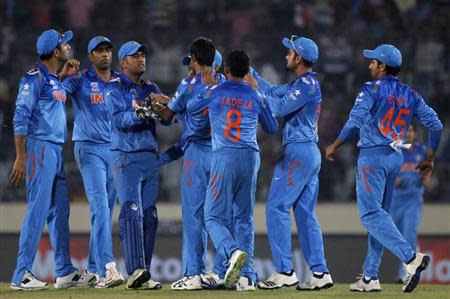ESPN looks to score with cricket stateside

By Liana B. Baker REUTERS - ESPN is hoping that a U.S. audience will warm up to another sport that uses a bat and a ball to score runs in innings but that isn't baseball: cricket. The No. 1 sports cable network, which is controlled by Walt Disney Co , has decided to air live cricket for the first time on one of its fully-distributed cable networks, ESPN2, which reaches a U.S. audience of 96 million homes. This Sunday at 9 am EST, the channel will show the finals of the World Twenty20 in Bangladesh pitting Sri Lanka against India. ESPN is experimenting to see if the sport can gain traction in the United States, where professional and college football are king while cricket, with its loyal but small fan base, is viewed as being on the fringe. ESPN, which is the main earnings driver of Disney, faces increased U.S. competition bidding for sports rights and for viewers with new entrants such as Fox Sports 1 , so it is casting a wider eye on other sports. After learning that the 10 most highly viewed Internet streams on its Internet-only network ESPN3, were of cricket matches, regularly beating out college football and basketball, executives considered putting it on TV. On March 30, 100,000 viewers tuned into the ESPN3 stream of an India-Australia match at one time, which is more than an average audience, the network said. "We think cricket has the chance to get out to a broader audience and be on a bigger platform," said Russell Wolff, executive vice president and managing director of ESPN International. While it might take some educating to make U.S. viewers more familiar with wickets and hitting a sixer, ESPN said the average U.S. cricket fan is young, highly educated and has a median household income of $75,000, which should appeal to advertisers. About 30 million people in the U.S. identify themselves as cricket fans, Wolff said. While this is tiny compared to the sport's popularity in India, Australia, England and countries in the West Indies, more people moving to the U.S. from cricket crazed parts of the world can only boost its growth. "You have a growing cricket interested population through straight population growth and through immigration patterns. You have a big and growing universe of people," Wolff said. Cricket is available to watch on networks such as Willow TV, but that's a specialty channel that costs subscribers $15 a month. ESPN's first big push into cricket came in 2007 when executives identified it as a global sport it wanted more exposure to and it bought Cricinfo - a cricket news website. Last year, Cricinfo was the second most googled website in India, trailing only the national train service, according to ESPN. While ESPN has shown all three versions of cricket online, including the format that lasts five days, it has made bets on the rights for the newer, faster growing formats. The T-20 format that will be shown on ESPN2, introduced about 10 years ago, lasts about three hours. The 2015 ICC World Cup, for which ESPN has locked up the U.S. rights, is the one day international format. ESPN has been trying to woo Madison Avenue by hosting events such as a viewing party for the India-Pakistan match at Hearst Tower in Manhattan attended by ESPN president John Skipper. But it still faces an uphill battle with advertisers like Hyundai, which said it has to do more research before investing. Selling the sport will be a challenge in a crowded U.S. marketplace where there's a major sport being played 12 months a year, said Jason Maltby, director of national broadcast TV at media buying firm MindShare. Still, Wells Fargo, which has done U.S. ads for cricket for six years and has previously placed ads on cricket on ESPN3, said it has increased its U.S. cricket budget this year, according to Michael Lacorazza, head of the company's integrated marketing. "Cricket may not be ready for prime time but with the world getting smaller, there's a realization that sports like these that are huge outside the U.S. can grow here," Lacorazza said. (Reporting by Liana B. Baker in New York; Editing by Christian Plumb, Bernard Orr)

